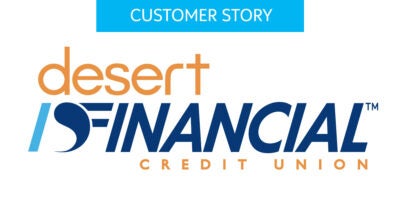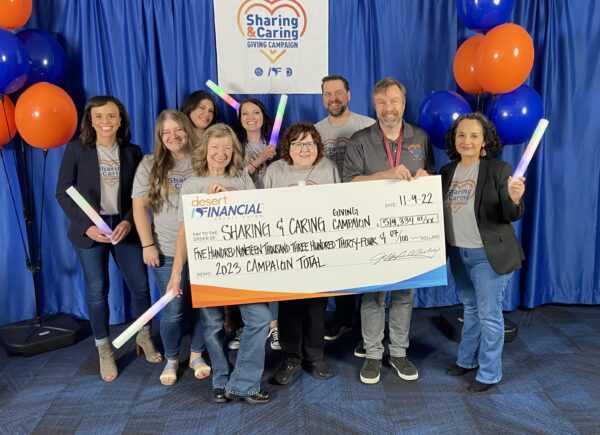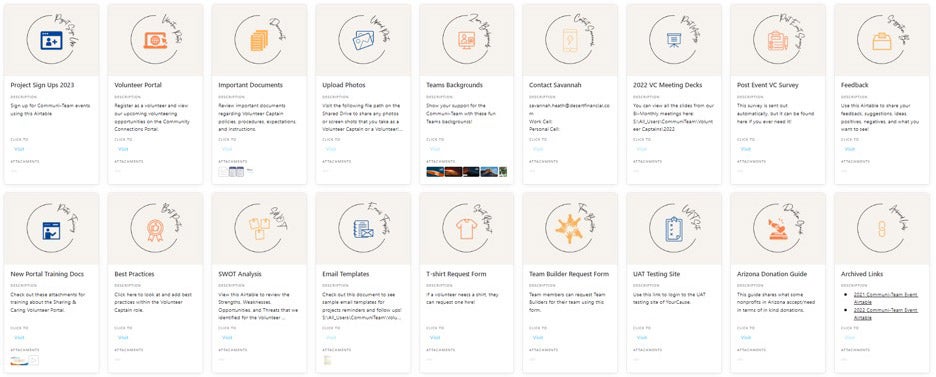Giving Back is a Cornerstone of Desert Financial’s Business

91%
Combined employee engagement
15,000+
volunteer hours in 2022
100+
Nonprofit partnerships
The community development program at Desert Financial was created 20 years ago and overtime the program has evolved to continually meet the needs of Arizona communities. Desert Financial has a wide variety of programs and initiatives with a focus on giving back to underserved communities. Their programs span from grants, sponsorships, Random Acts of Kindness, Teacher Appreciation and employee giving and volunteering.
We interviewed Carlissa Wright, Vice President of Community Development and Savannah Heath, Community Engagement Program Manager, to learn more about the nuts and bolts of how they operate a robust year-round employee giving and volunteering program that engages 91% of their employees. Desert Financial had the highest combined engagement rate among companies evaluated in the 2023 CSR Industry Report with 1,000-5,000 employees.
Carlissa, give us a little background on how the workplace giving program has evolved as the business branched out to serve new communities across Arizona and how you incorporate employee feedback.
Previously, our workplace giving was conducted through United Way, the transition to YourCause has allowed us expand giving to multiple nonprofits. That was really important to us because we wanted to give back across counties where we have branch locations. We conducted an employee survey to understand the social issues that are important to our team members and learn about why they give back. This allowed us to see where our corporate philanthropy aligned with causes that our employees are passionate about. Employees have the opportunity to give feedback throughout the year and we continue to survey them at the end of every campaign to understand their experience with participating.
Our employees continue to blow us away with their commitment to the community. We see a benefit in using the annual pledge campaign to dedicate a time that we can all rally around important causes, create customized messaging, and really excite employees making their pledges for the next year. We also keep year-round giving open to allow any new employees the opportunity to give, or employees that can’t commit to a pledge, the opportunity to give when they can. We increased our commitment by 6% and between employee donations and company match we committed over $500,000 for the 2023 campaign.
The image shows Carlissa and Desert Financial employees celebrating with a big check for the total giving pledge campaign amount.

What are 3 things that drive participation with your programs across giving and volunteering? Carlissa: Commitment from executive leaders.
Our executive leadership team is highly engaged with our giving and volunteering programs. They are encouraged to serve on nonprofit boards and giving back is embedded into the common annual goals, 10% of volunteer hours are from leadership alone.
Savannah: Communication consistency is key!
We have a regular cadence of updates for employees, and we send monthly reports to senior leadership on engagement metrics.
I post something every Friday to the employee intranet that shares the impact our team has made thus far, provides opportunities to get involved, and promote the company value of giving back. We consistently provide information on upcoming volunteer opportunities and fundraising that employees can sign up for both at work and on their own.
Savannah and Carlissa: Our Volunteer Captains make the robust program possible.
These employees share the enthusiasm and become an extension of the CSR department. They are using our campaign background in their team’s meetings and talking about the impact they are making across the company so people are aware of the difference we are making and want to become involved.
Our Volunteer Captains have a leadership role that they take seriously. To become a Volunteer Captain, they must be a top volunteer, go through a training, and shadow a current volunteer captain. We have a checklist that Volunteer Captains follow to keep the communication cadence consistent for promoting upcoming events, sending reminders to employees who signed up, and making sure employees know the details for the event they are participating in. They act as our onsite coordinator as well, and it makes the employee experience so much better when they see that smiling face on the day of the event. By providing an exceptional experience, Volunteer Captains make employees want to volunteer again and again.

How are you showing the value of your programs to employees and inspiring them to volunteer year-round?
It would not be possible without the level of commitment and engagement from our Volunteer Captains. The Volunteer Captains are a critical part of making this a turn-key system.
Our employees just have to sign up and show up. We work really hard to remove any barriers for them participating and that shows how much we value their time commitment. We make sure to tell them exactly what they are doing and if they can bring their families to participate. It was a huge win for our employees to easily add the event to their Outlook calendar after they signup once we transitioned to YourCause. We usually have 20-30 volunteer opportunities per month in the portal for people to choose from, supporting a number of different social issues, and we encourage everyone to use their paid volunteer time off.
We operate at a high level of excellence in planning and executing these events so that it is impactful for our employees and our nonprofit partners. We’ve built relationships with over 100 nonprofits so that we can continue to offer a variety of volunteering activities, including in-person, virtual and skills-based opportunities. We have a survey at the end of every volunteer event so that we can benchmark the employee experience.

Savannah, how are you using reporting and data to make strategic decisions and set goals for the future?
I look at different reports every day! The datahub has been really helpful to see standard reports, and I have experience with Tableau, so I have a lot of custom reports for measuring hours, event capacity, and engagement over time. I use Airtable to compare current months data with benchmarks for each metric. These benchmarks are a combination of industry standards I’ve seen in reports as well as looking at historical employee engagement data and setting a stretch goal for what I think we can accomplish every year. Like Carlissa mentioned earlier, our employees continue to blow our goals out of the water. Last year, we set a goal of 12,000 hours and we made it to over 15,000. We also measure the success of the program by collecting feedback from nonprofits and looking at a satisfaction metric from the survey after every event. We also imported historical data into the system so we can use Tableau to see changes in trends and behavior over time. Below is a list of a few metrics + how Savannah uses it.
Event Capacity
We want to make sure events are 75% ore more full, so that we aren’t just sending two employees to volunteer when a nonprofit needs twenty.
Participation among newly hired vs. tenured employees
We introduce our programs to new employees on day one and give them a Cause Card to immediately get in the system and make a donation. We also plan a volunteer event for new hires to participate in week one. We track redemption rate and participation among these groups.
Monthly participation and hours Quarterly participation and hours
The beginning of the year is usually a slower time, but this year we promoted and made sure to create events for our employees within the first 3 months. We saw the highest participation in Quarter 1 to date.